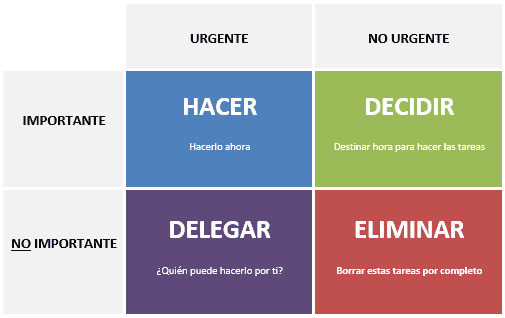In recent years I have been learning and growing a lot through ideas and experiences that other people share online, and I have been keeping some of the ideas or advice that seemed most interesting to me. One of these small reflections (unfortunately I don't remember who I heard it from) is that, although in everyday language they may seem like two very similar terms, there is a great difference between what is Urgent and what is Important.
Many times it happens that you only have a couple of pending tasks, and if one is urgent, it is also immediately labeled as important. Likewise, it is also the case that an important task can easily be categorized as urgent. If you stop to think about it, this is not exactly the case, and when your range of tasks is really wide, you begin to distinguish very clearly what is important, from what is urgent.

Differentiate what is Urgent from what is Important
As I mentioned in the previous paragraph, when dealing with several plans or projects at the same time, it is necessary to know how to recognize these two terms:
- A plan urgent is one who has a next date set.
- A plan important, on the other hand, is one that needs to be finished sooner or later, due to its high relevance compared to the rest of the plans.
In this way, for example, for a student the Final Year Project is something highly important, but perhaps it is not urgent because it is still at the beginning of the course, and in that case submitting the work for that week could be something urgent although not so important, since not handing in an assignment is not going to mean such an alarming loss of grade.
It may be a somewhat silly detail, but until now I had always worked with WhatsApp as my personal agenda, and all the tasks I had to do were classified into three types: Low Priority, Medium Priority, or High Priority.
In these cases, if a task was urgent, or important for the future, its priority was High. I had not stopped to think that perhaps a task could be super urgent but completely unimportant, and that perhaps dedicating an entire afternoon to that matter was taking time away from other, much more relevant tasks.
Once you stop to think about it, up to 9 possibilities arise, which I personally want to focus on as follows:
- Importance high and Urgency high: Maximum concentration and work on it.
- Importance high and Medium Urgency: I am dedicating some time to it every day.
- Importance high and Urgency Low: I'm giving it shape and leaving some bases prepared, each week.
- Medium Importance and Urgency high: You have to dedicate some time to it unless there is something of greater importance with the same urgency.
- Medium Importance and Medium Urgency: I leave it written down and dedicate some time to it each week to take my mind off other tasks.
- Medium Importance and Urgency Low: I leave it noted to review and evaluate it again in the future.
- Importance Low and Urgency high: See if it is possible to make time for it and if so, dedicate some time to it.
- Importance Low and Medium Urgency: I leave it noted to review and evaluate it again in the future.
- Importance Low and Urgency Low: I leave it written down and forget.
Eisenhower Decision Matrix – Urgency and Importance
The simplified scheme that graphically represents these subtle differences is known as the Eisenhower Decision Matrix, with the four rules of
- Do.
- To plan.
- leave it for later of Priority 1 tasks or Delegate.
- Postpone it for when there is nothing else or directly Eliminate.

I hope this small contribution has made you think a little and can help you achieve better planning when the need arises ^^
